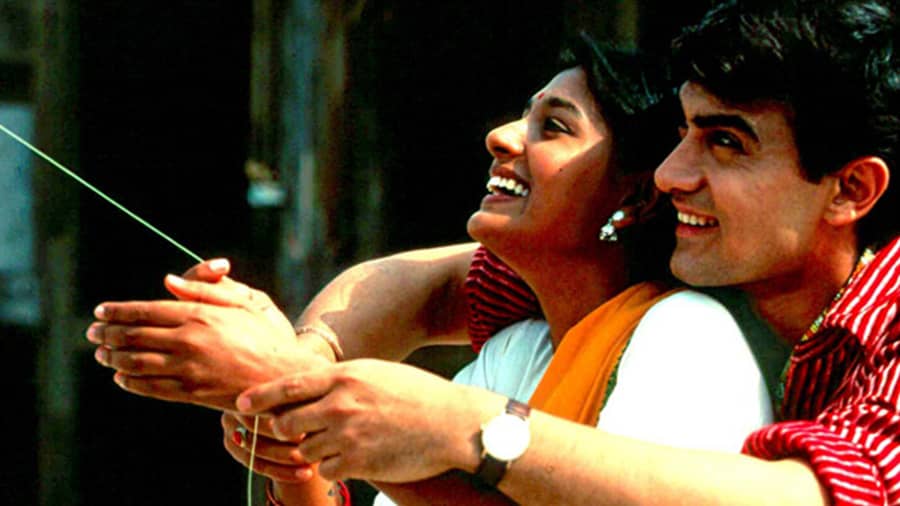Kite flying is usually associated with Makar Sankranti festivities in the western part of India, or with Independence Day celebrations in Delhi. But in West Bengal, little squares of different colours flying in the air is a part and parcel of Vishwakarma Puja. On this special occasion, we take a look at eight Indian films where kites play an important role.
Ruth Aa Gayee Re, from 1947 Earth (1999)
This song from the second film in Deepa Mehta’s Elements Trilogy features Aamir Khan and Nandita Das. A boisterous, celebratory song, it hints at a budding romance between the characters. A.R. Rahman’s soulful composition captures the mood of the scene — a riot of colours in the sky as kites of various shapes fly high, and the friendly banter between Dil Nawaz (Aamir Khan) and Shanta (Nandita Das).
Dheel De, from Hum Dil De Chuke Sanam (1999)
This is also a celebratory song depicting the Makar Sankranti festivities. It comes at a turning point in the film right after Sameer (Salman Khan) kisses Nandini (Aishwarya Rai) on her hand — their first, but brief, physical encounter. The folksy song-and-dance number, from Sanjay Leela Bhansali’s directorial, also reflects Nandini’s cheerful mood. This song is also the last celebration for Nandini and her family as a massive twist follows soon after.
Kites (2010)
Director Anurag Basu has used kites metaphorically in the film. Just as kites fly against the wind and fight to survive, the characters in the movie struggle on in life, with all their insecurities and follies. Kites soar as wind currents become stronger; Jay (Hrithik Roshan) and Natasha’s (Barbara Mori) love also deepens as they face hurdles.
The Japanese Wife (2010)
There’s a sequence in this Aparna Sen film where Snehamoy (Rahul Bose) receives Japanese kites from Miyage (Chigusa Takaku), with whom he is in a long-distance marriage. These are big, colourful kites with faces printed on them, unlike the ones usually seen in Bengal. Villagers are opposed to Snehamoy flying them for the local competition but he is adamant. The scene where these vibrant kites from Japan adorn the sky is a delightful watch.
Gattu (2012)
Directed by Rajan Khosa, Gattu tells the story of an orphan who works for his uncle. His real passion, though, is flying kites. He is fascinated by the kite, Kali, which has won many competitions and remains unbeaten. Gattu is determined to beat this black kite and is willing to go to any length to fulfil his dream.
Yeh Khula Aasmaan (2012)
The Gitanjali Sinha directorial is another film where kites play a symbolic role. A grandfather (Raghubir Yadav) uses kites to teach surviving skills to his grandson, Avinash, and prepare him for life. Haunted by repeated failures in academics, Avinash is going through a rough patch. His parents, too busy with their careers, do not have time for him and his ‘Dadu’ fills the vacuum.
Kai Po Che (2013)
The film’s title itself is a phrase associated with kite flying. Directed by Abhishek Kapoor and starring Sushant Singh Rajput, Rajkummar Rao and Amit Sadh, Kai Po Che has some memorable sequences depicting the festival of Uttarayan in Gujarat. Based on Chetan Bhagat’s novel Three Mistakes of My Life, the kite flying sequences highlight one of the ‘mistakes’ that Govind (Rajkummar Rao) commits — falling in love with Ishaan’s (Sushant Singh Rajput) sister.
Ambarsariya, from Fukrey (2013)
This earthy song beautifully captures the budding romance between two youngsters — Hunny (Pulkit Samrat) and Priya (Priya Anand). Hunny is besotted with Priya and wants to convey his feelings. A kite acts as the messenger here. Hunny writes his thoughts on the kite and sends it across to Priya’s terrace, who then gladly reciprocates. Sweet, isn’t it?











